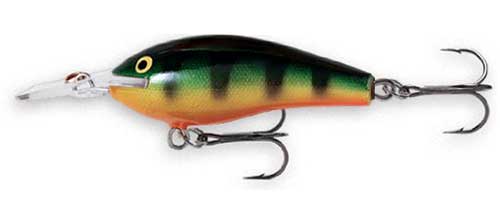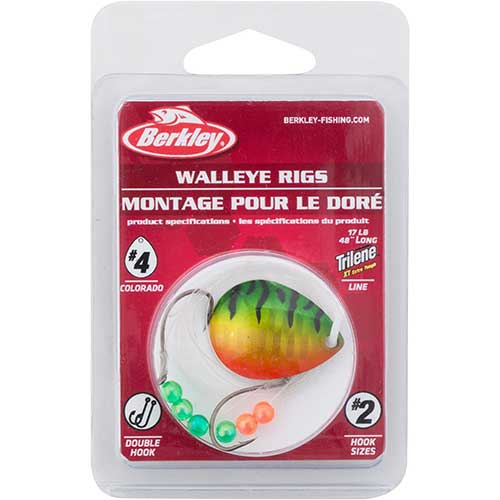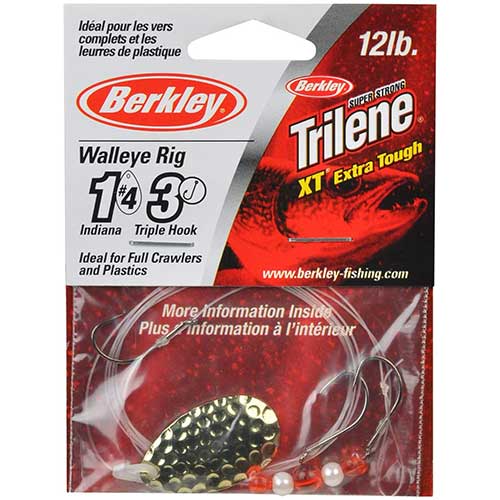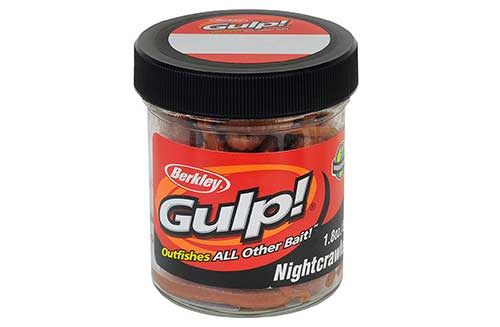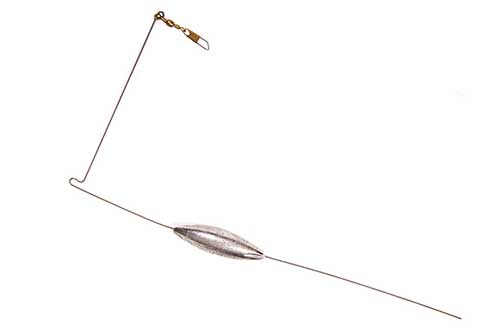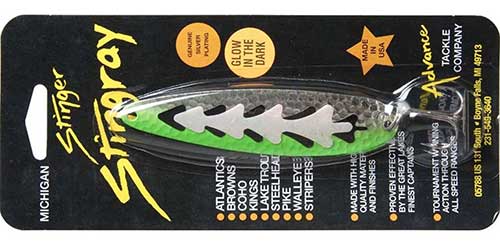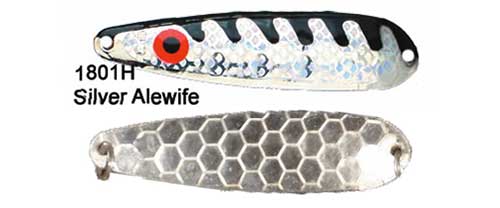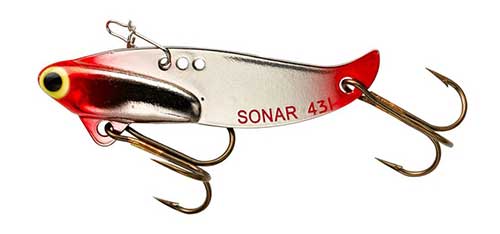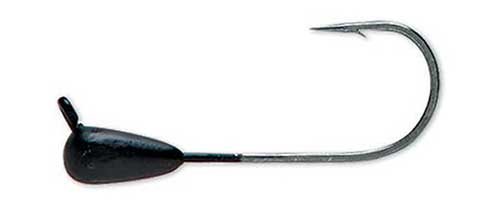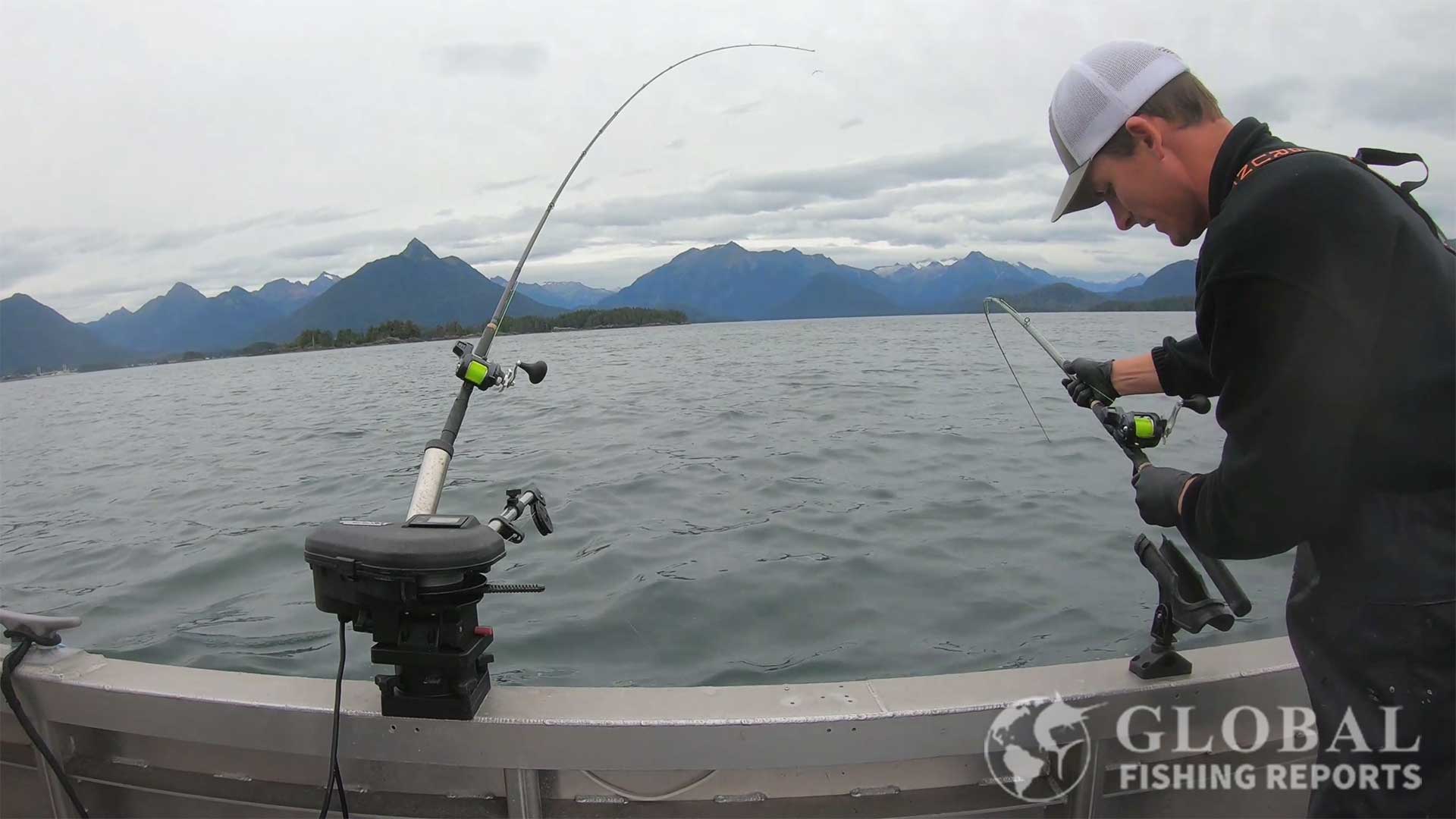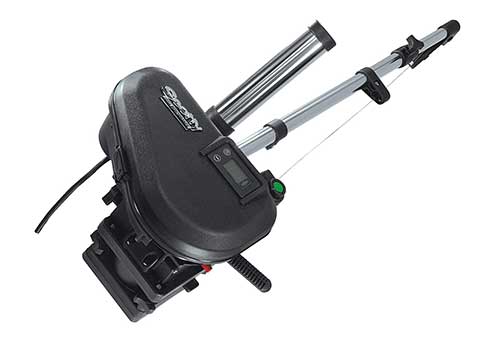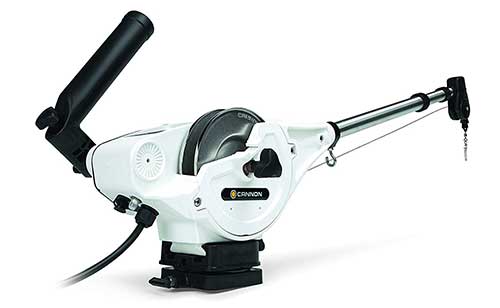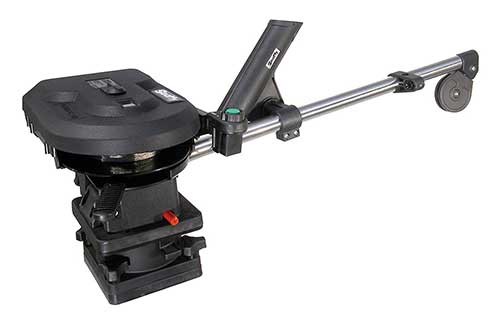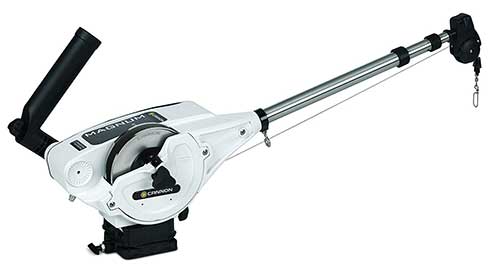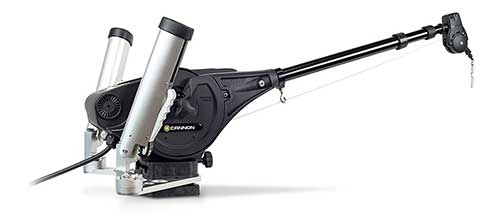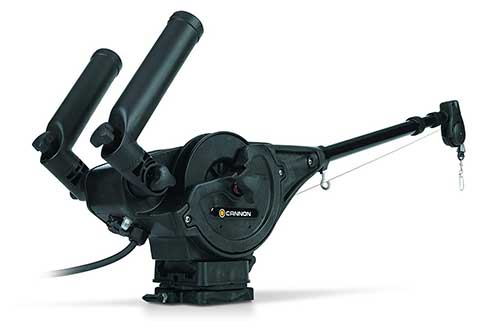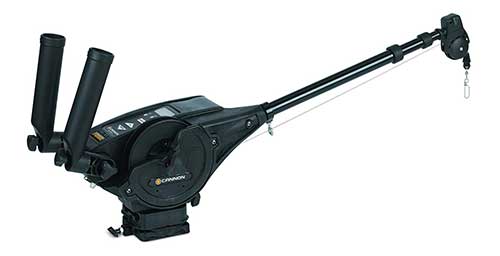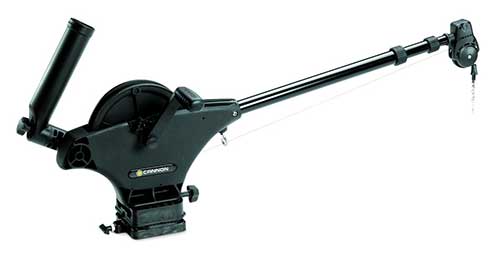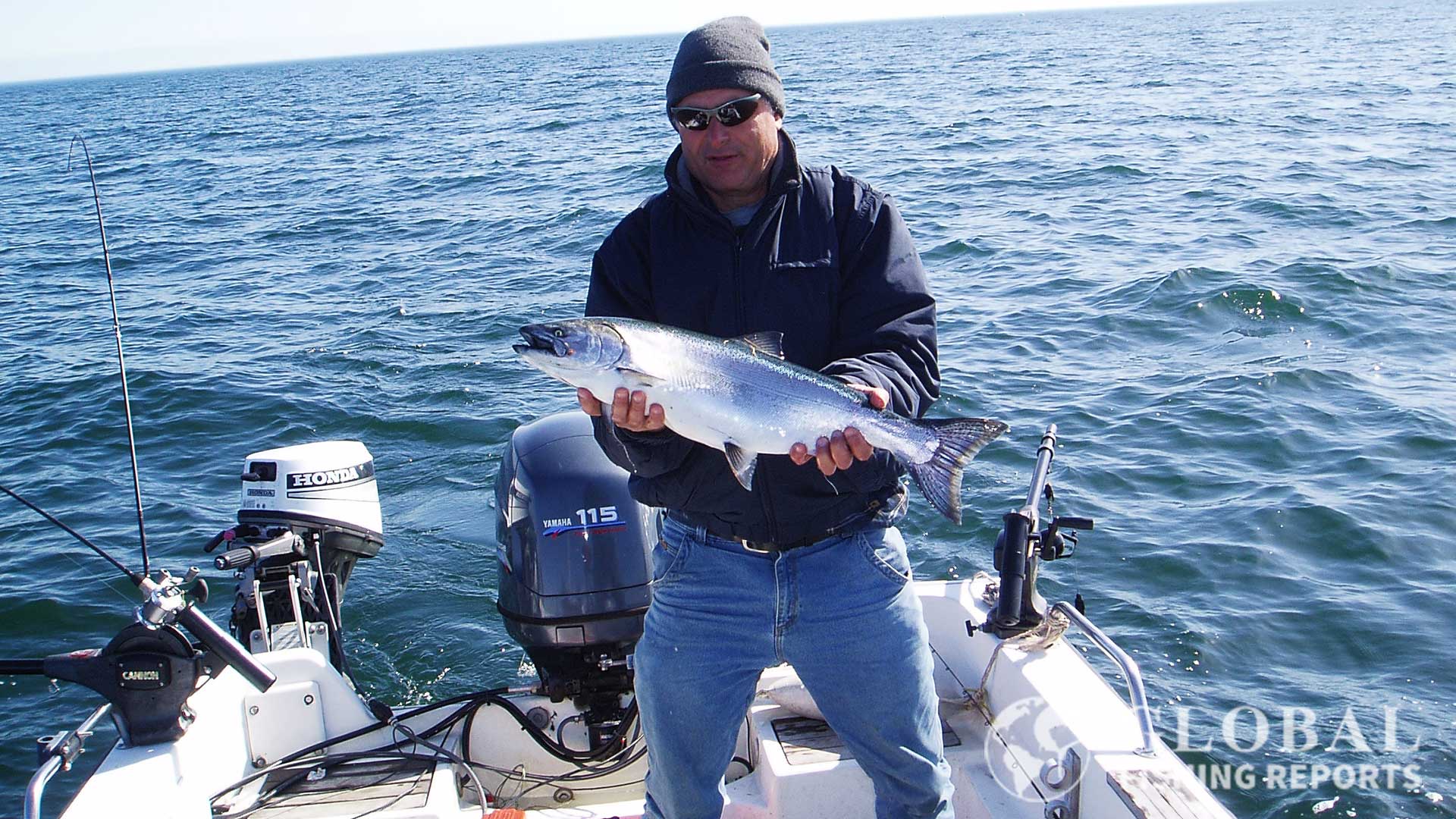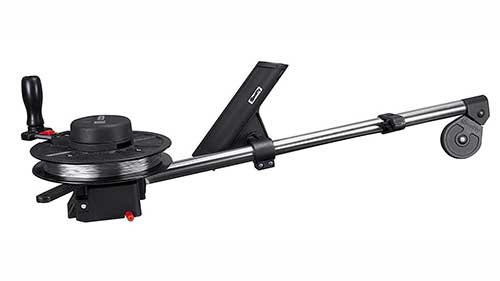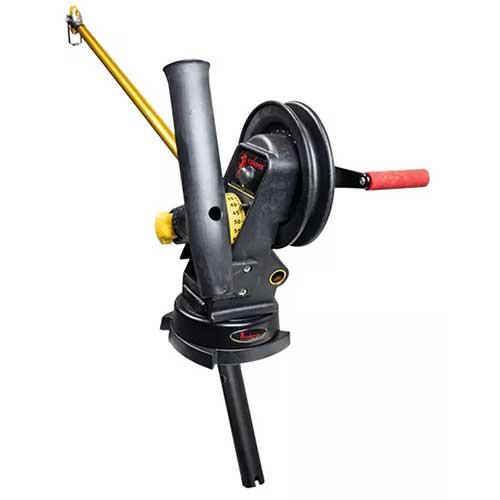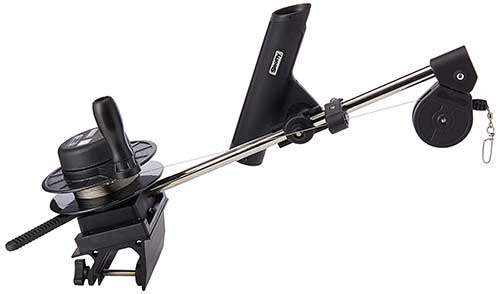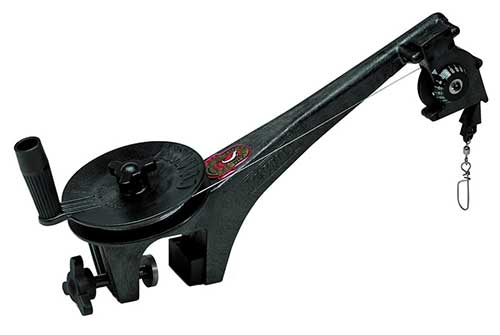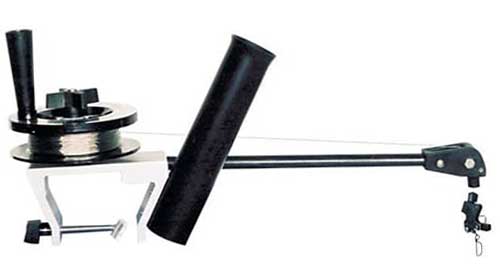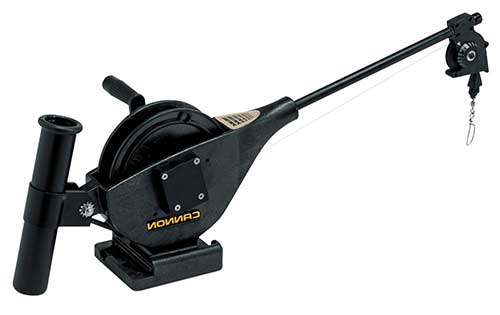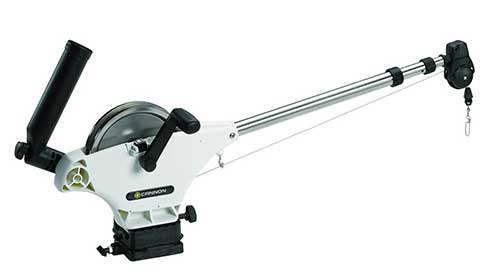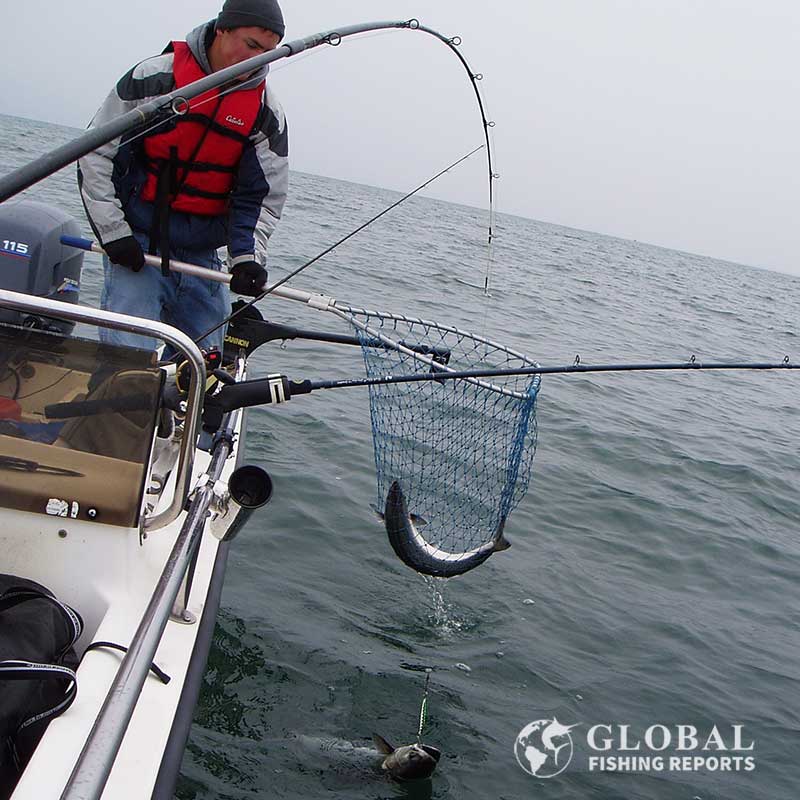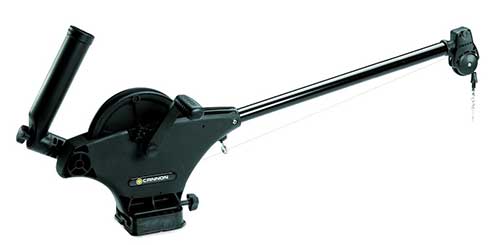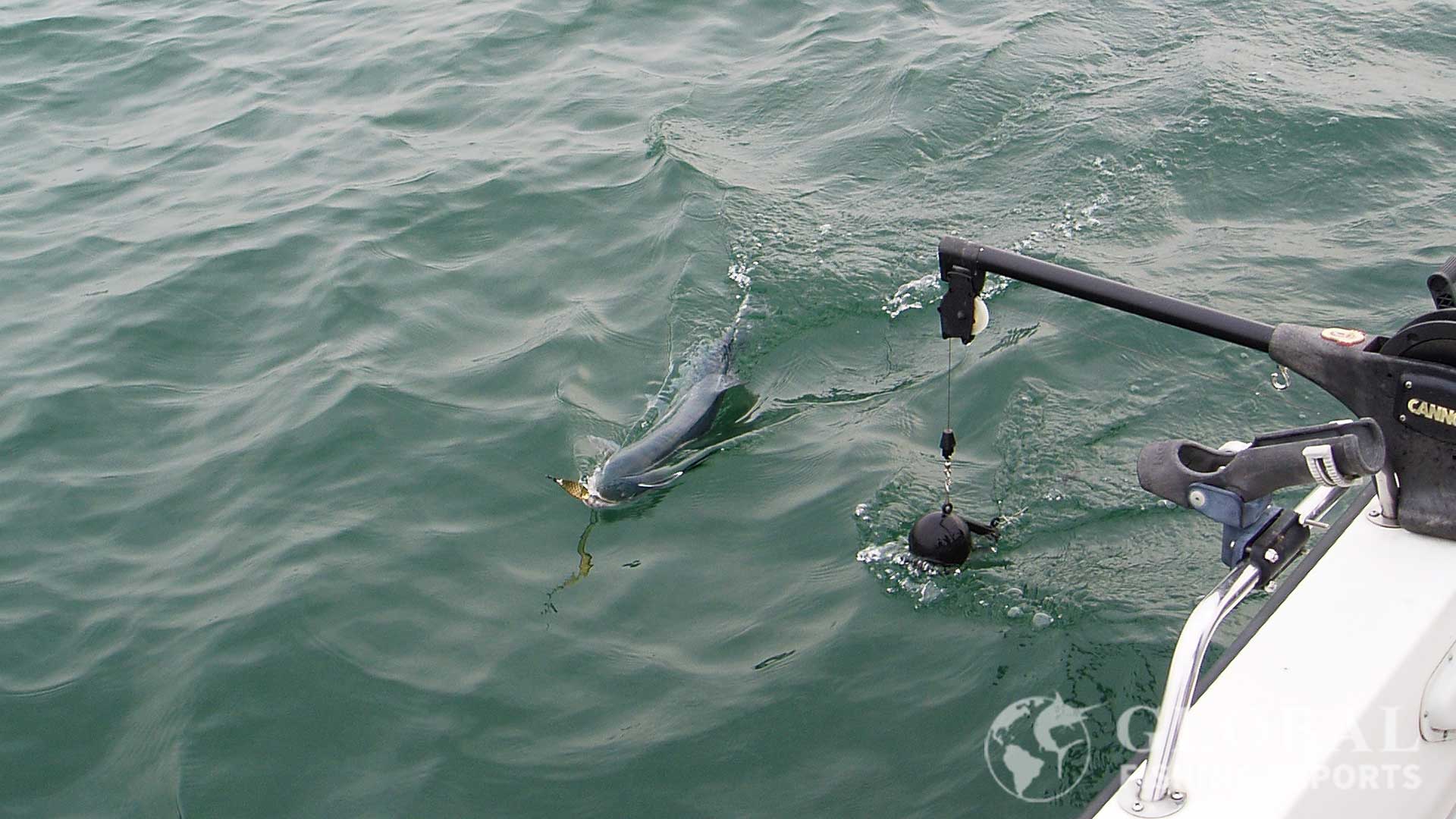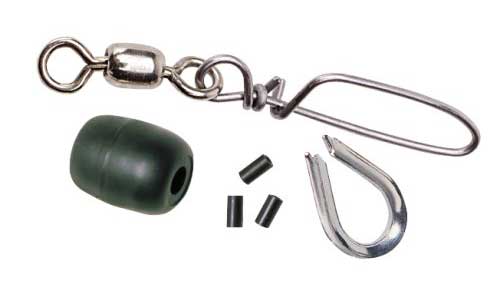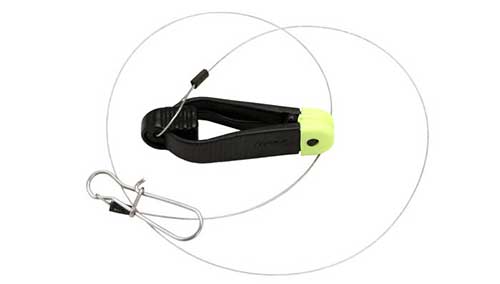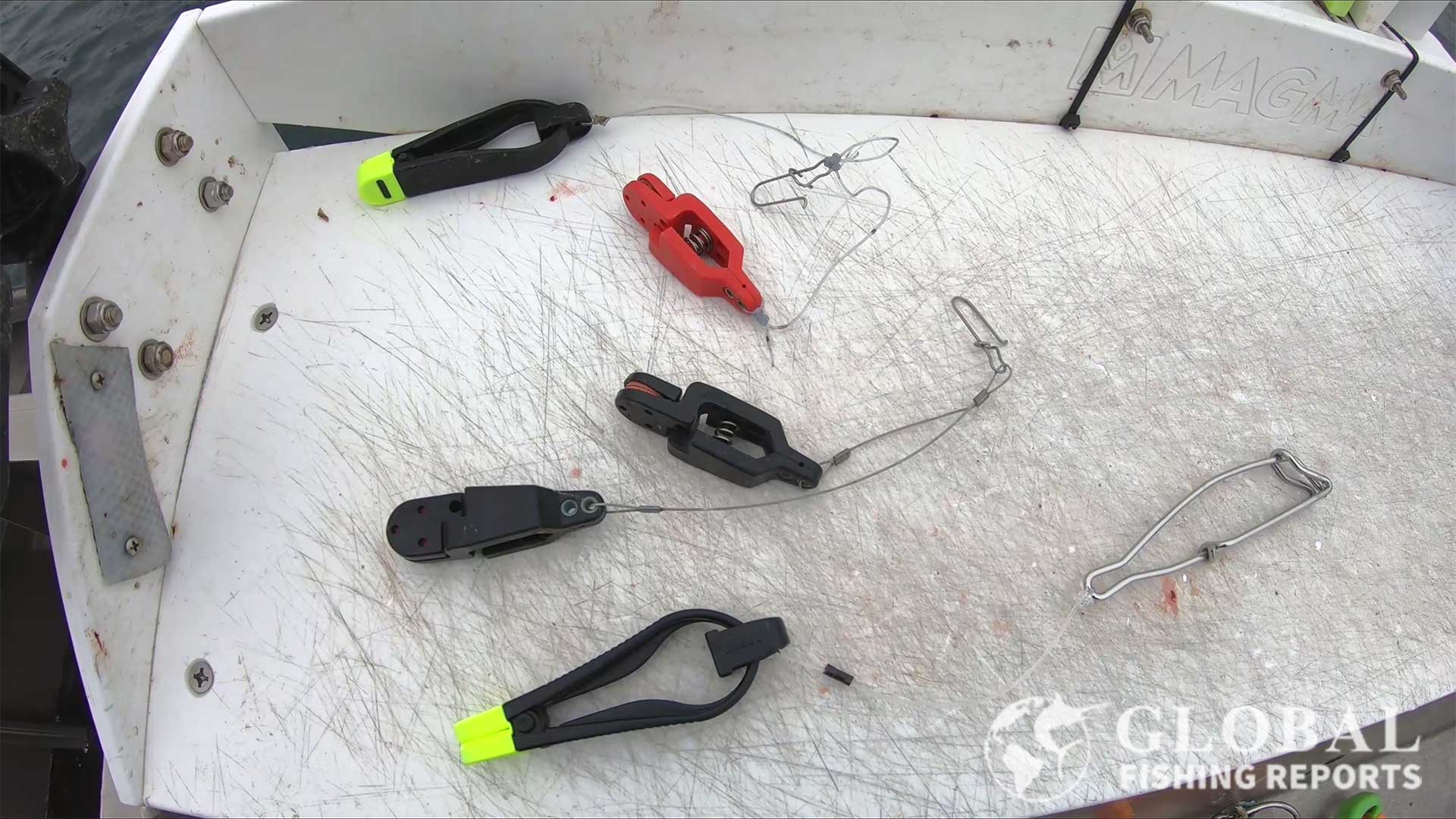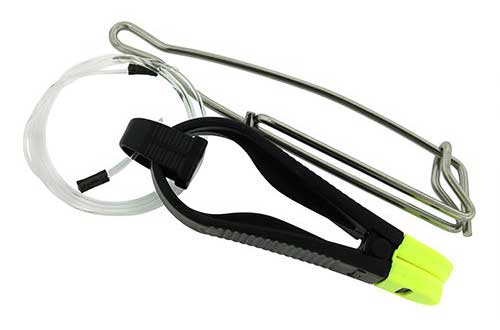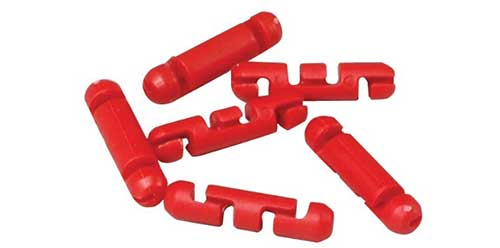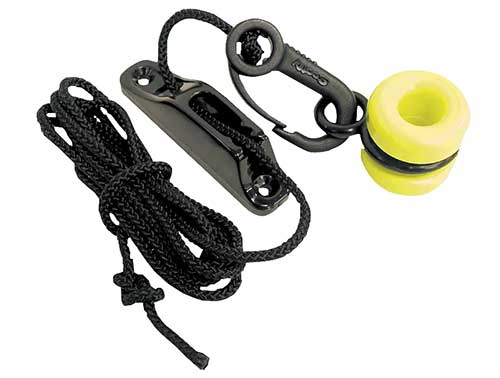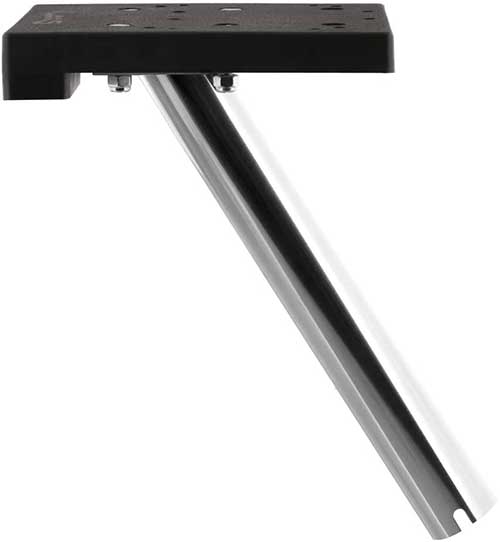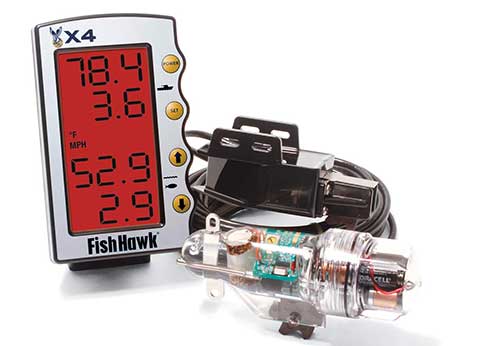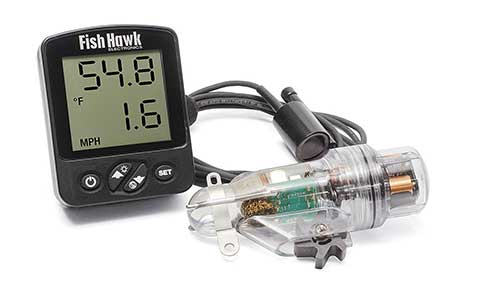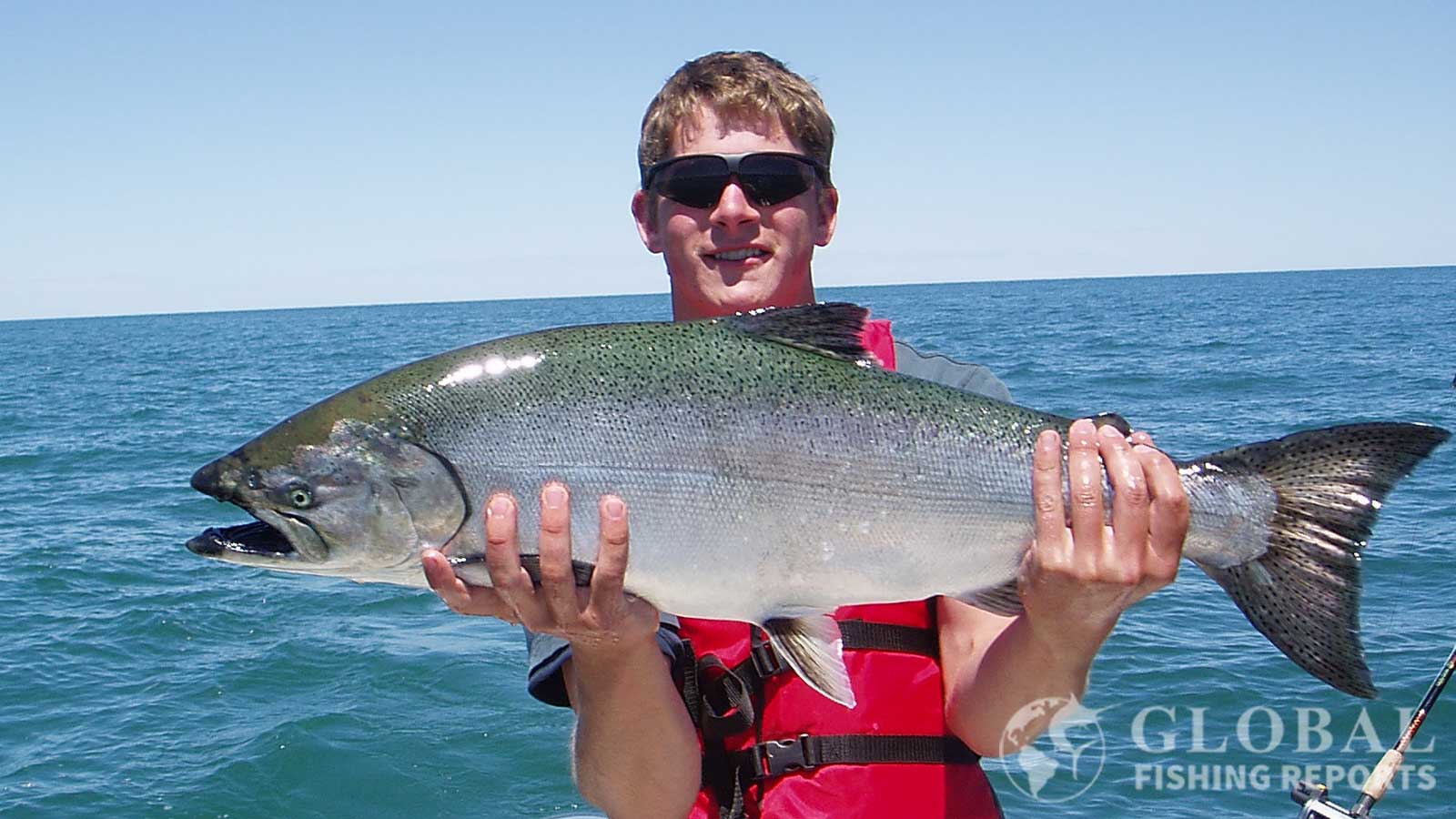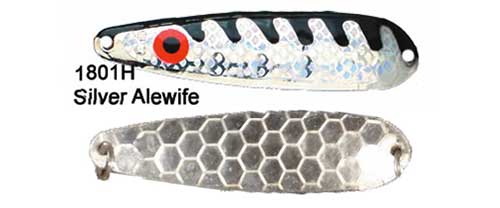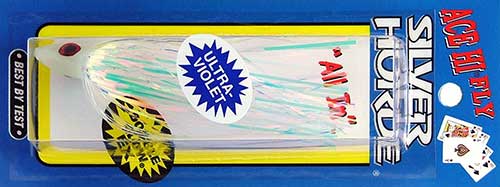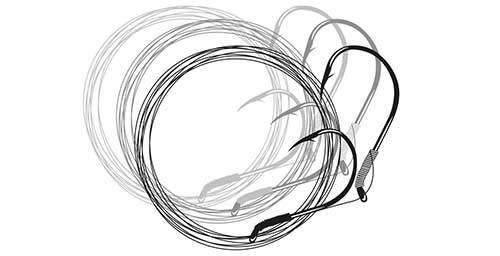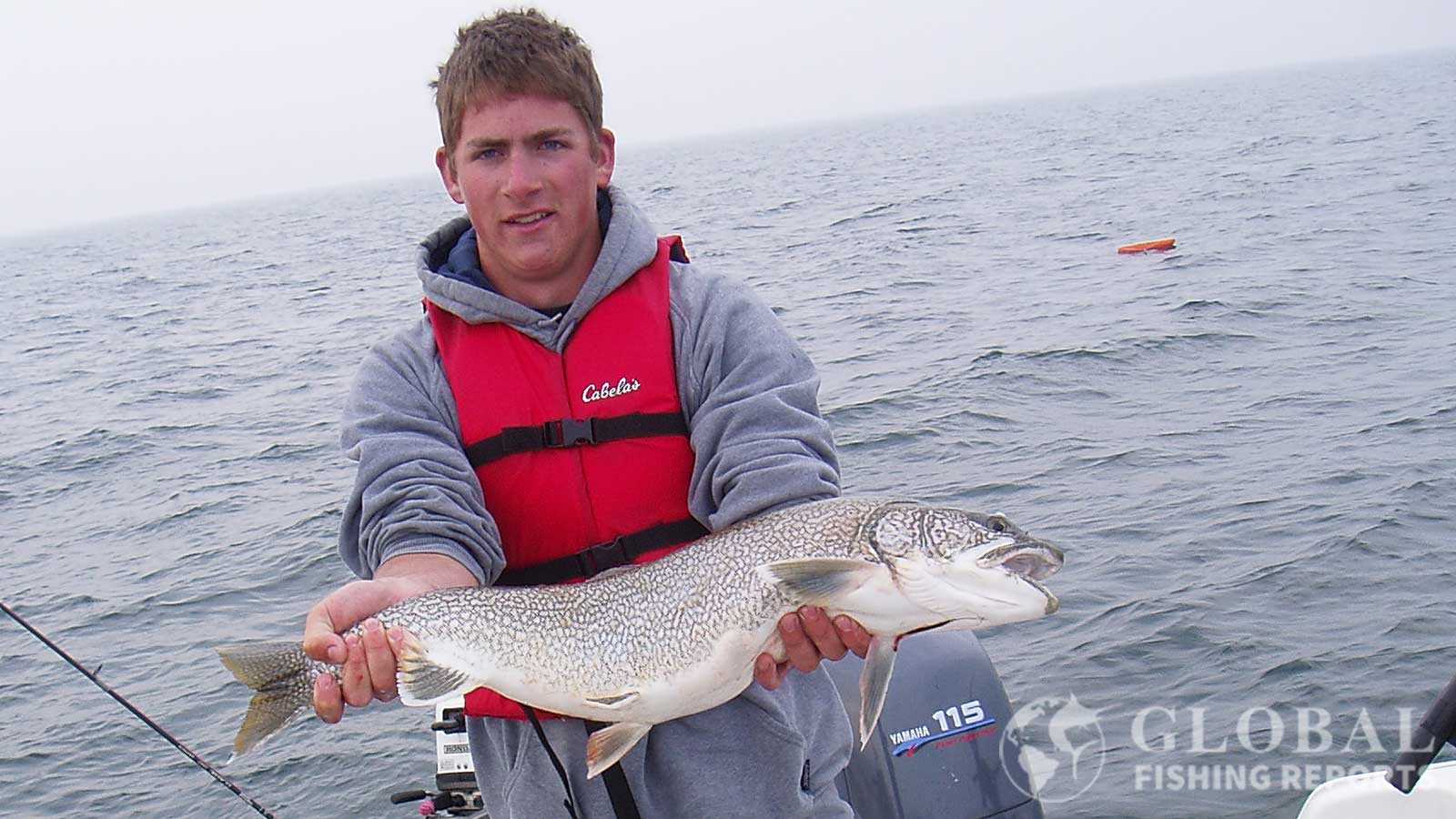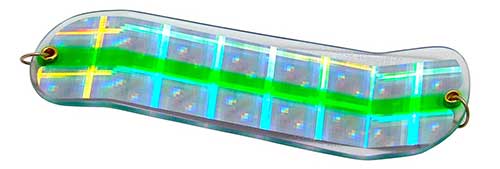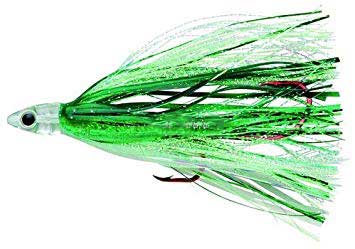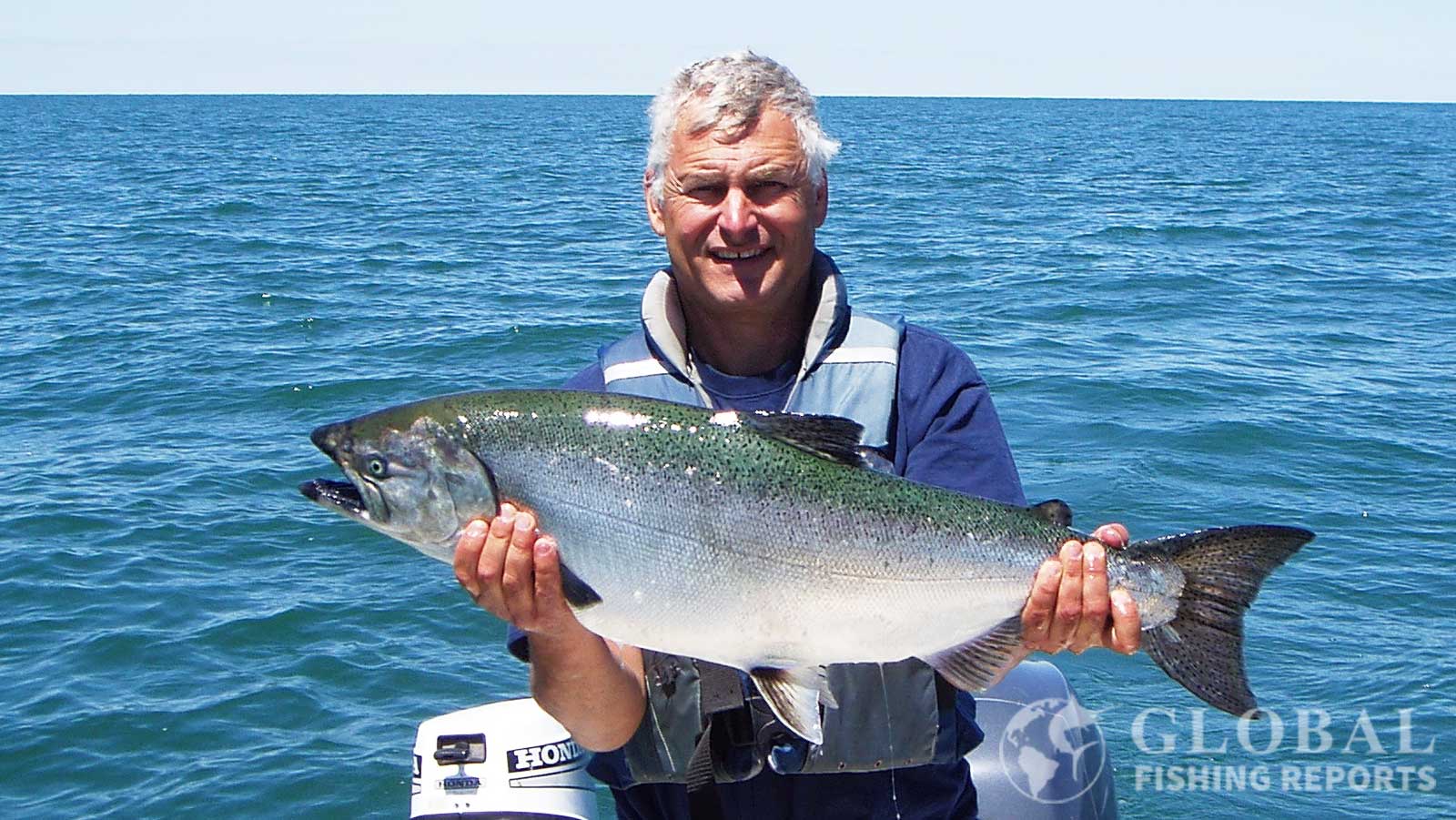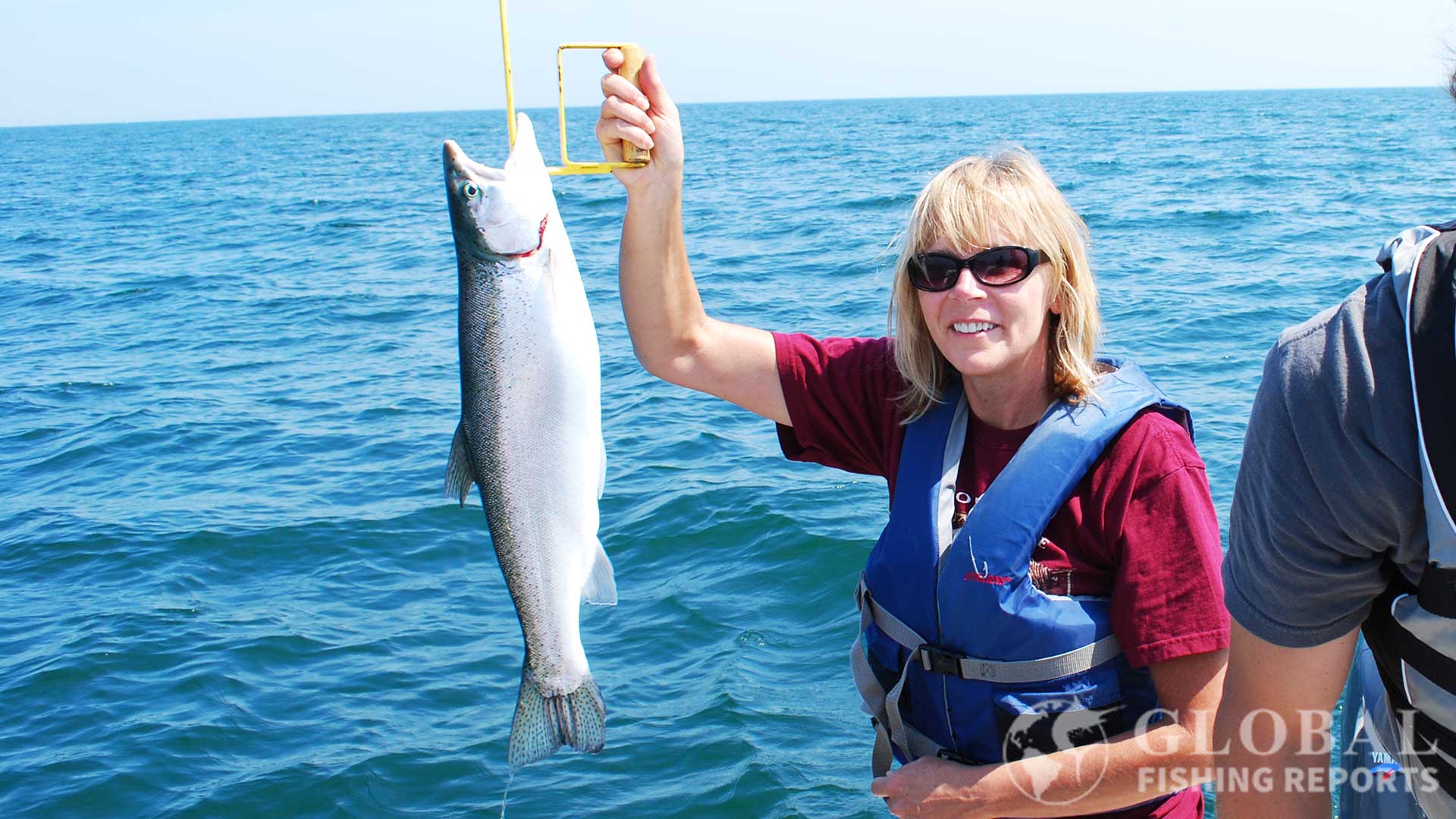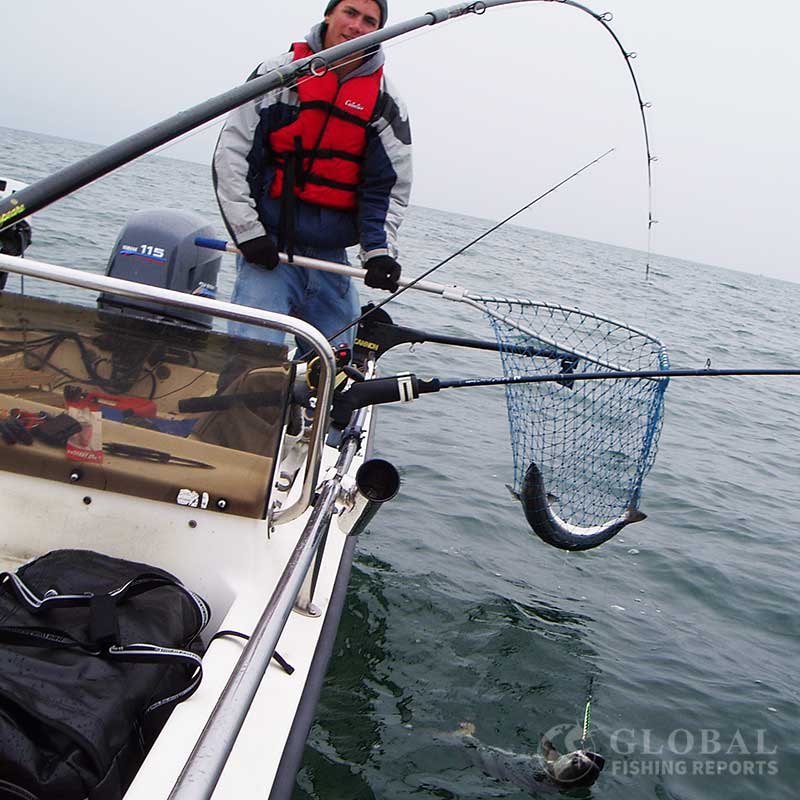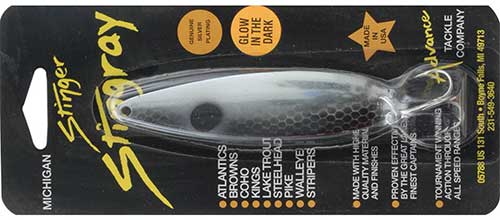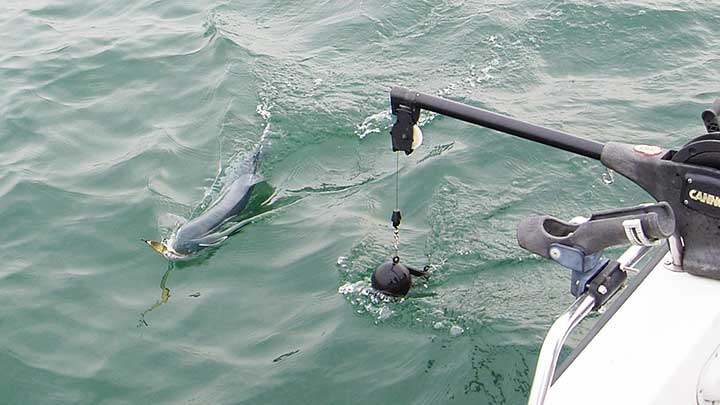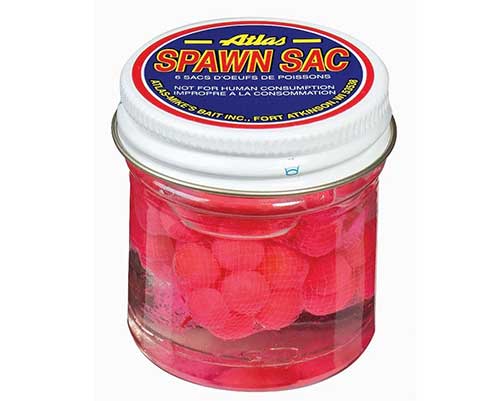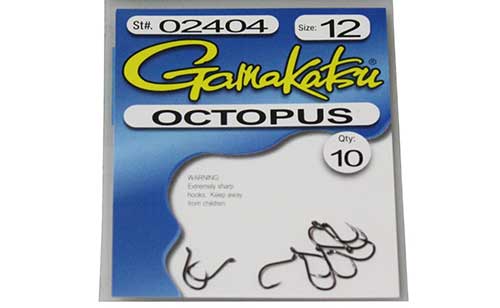Lakes are often full of walleye but are not frequently caught unless they are being targeted. They are known to be low-light feeders and feed well at night but they also feed and bite during the day! One thing that makes walleye fishing fun is that they are a good-eating freshwater fish.
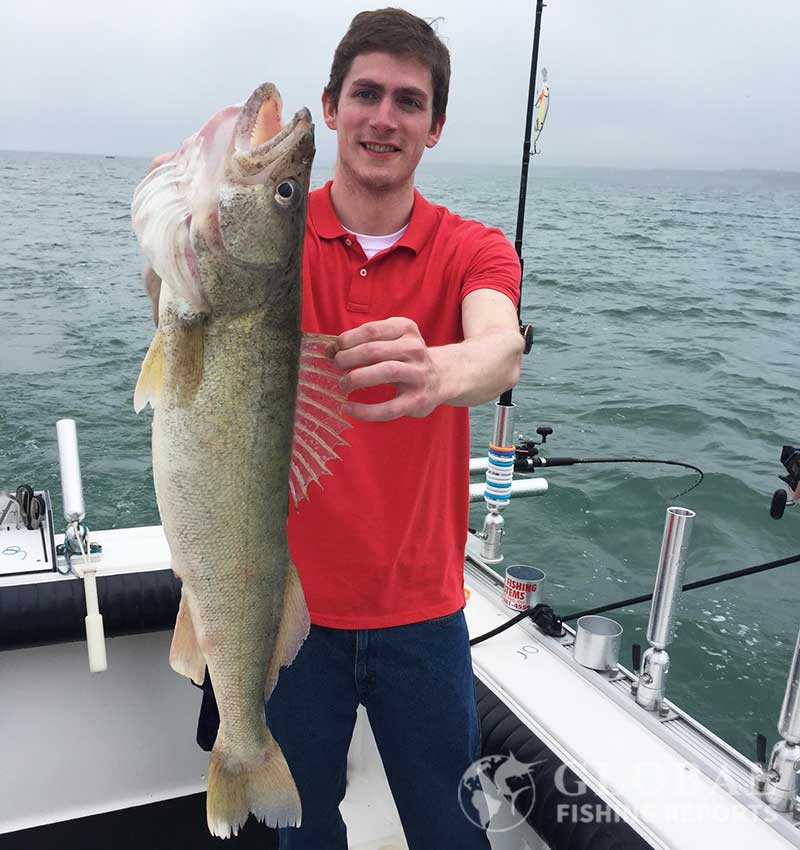
Understanding Walleye Behavior and Biology
Walleye can see better at night than any other freshwater fish which gives them an advantage over their prey. Their eyes cannot see blue and yellow but can see red and green. This is why most Walleye lures are colored red and green. This does not mean that only red and green lures work because walleye can still see reflections and shading variations from other colors.
Water filters out red significantly at depths greater than 20 feet. This means that for lures going down more than 20 feet green, black and shiny colors make more sense.
It is recommended to fish for walleye in less than 40 feet of water mainly because this is where most walleye live, including big walleye. Secondly, if a fish is brought up that is short or that is not going to be kept the fish will not get hurt or killed when the swim bladder expands due to the decrease in pressure.
Sometimes people think of walleye as a slow fish that can only eat worms. It is true that walleye are fished slowly but they are an aggressive fish with a mean strike. Adult walleye primarily eat fish such as yellow perch, alewife, and ciscoes. They can be caught using large plugs, stick baits, jigs, and worm harnesses.
Best Trolling Techniques for Walleye
Trolling is one of the most effective methods for targeting walleye, especially in larger bodies of water. Here’s what you need to know:
Using Downriggers
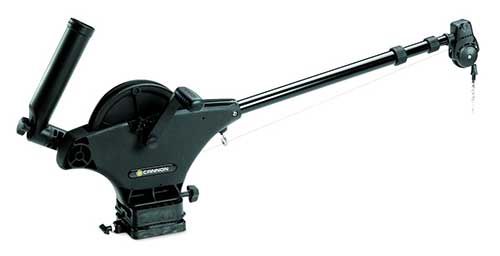
Downriggers help to target walleye at deep depths and very specific depths. When using a downrigger, spoons, worm harnesses, and stick baits can all be used. While trolling watch the fish finder close and adjust the depth of the baits accordingly. One line should always be set just a few feet off the bottom.
When walleye fishing in the great lakes it is also common to catch bass and salmon. Trolling for walleye is done with conventional fishing reels that are also used as salmon trolling reels. The reels used with downriggers do not need to have line counters. Reels set on flatlines, dipsey divers, and jet divers should have line counters. Line counters are also nice when jigging for walleye to help determine the depth.
Dipsy Divers and Jet Divers

Dipsy divers perform two functions. Dipsy’s bring the lure deeper and off to the side of the boat. How far to the left or right they will go can be adjusted by rotating the base plate of the Dipsy. Dipsy Divers come in three sizes 3/0 mini 2-1/4 inches, 0 small 3-1/4 inches, 1 large 4-1/8 inches, and 3 magnum 4-7/8 inches. These can reach a max depth of 20 feet, 40 feet, 70 feet, and 100 feet, respectively. Depth is primarily based on the amount of line let out but troll speed is a factor. Typically these are all trolled at a speed less than 2.5 mph. A braided line will set the rig deeper than a monofilament line. These are a good way to get spoons, stick baits, and worm harnesses to deeper depths!
Optimal Trolling Speeds
Walleye fishing is done by either trolling or drift fishing. When trolling spoons and deep-diving plugs typical speeds are 2.0-2.5 miles per hour. For worm harnesses troll speeds are typically between 1.5-2.0 miles per hour. The speed for drift fishing is mostly based on the wind. If there is a strong wind worm harness works well. If the drift is really slow working jigs is an effective method. Anchoring up with lots of scented bait could work as well but it a less common walleye fishing technique.
Deep Diving Lure Options
Bandit Deep Diver Walleye Trolling Lure
The Bandit deep diver is 4-3/4 inches in length. It comes in a variety of popular color patterns such as Green, coconut candy, chartreuse green-black, green clown, and red. This is a go-to lure for many charter boat operations in the Great Lakes. The key is being at the correct depth for the fish.
The depth of the lure is controlled mainly by how much line is let out and a small amount by the trolling speed. Precision Trolling sells an app that contains detailed depth charts for this lure and hundreds of other trolling lures and crankbaits.
Example dive depths for this lure are 30 feet of line is 10 feet down, 90 feet of line is 18 feet down and 195 feet of line in 22 feet down. Typical troll speeds are around 1.8 miles per hour. The lure dives a bit deeper with braided line and shallower with standard monofilament line. If a braided line is being used a four to six-foot fluorocarbon leader is needed. The leader can be tied line to line or with a barrel swivel. To determine how much line is let out a line counter reel can be used. These reels are often used for salmon, steelhead, and walleye fishing.
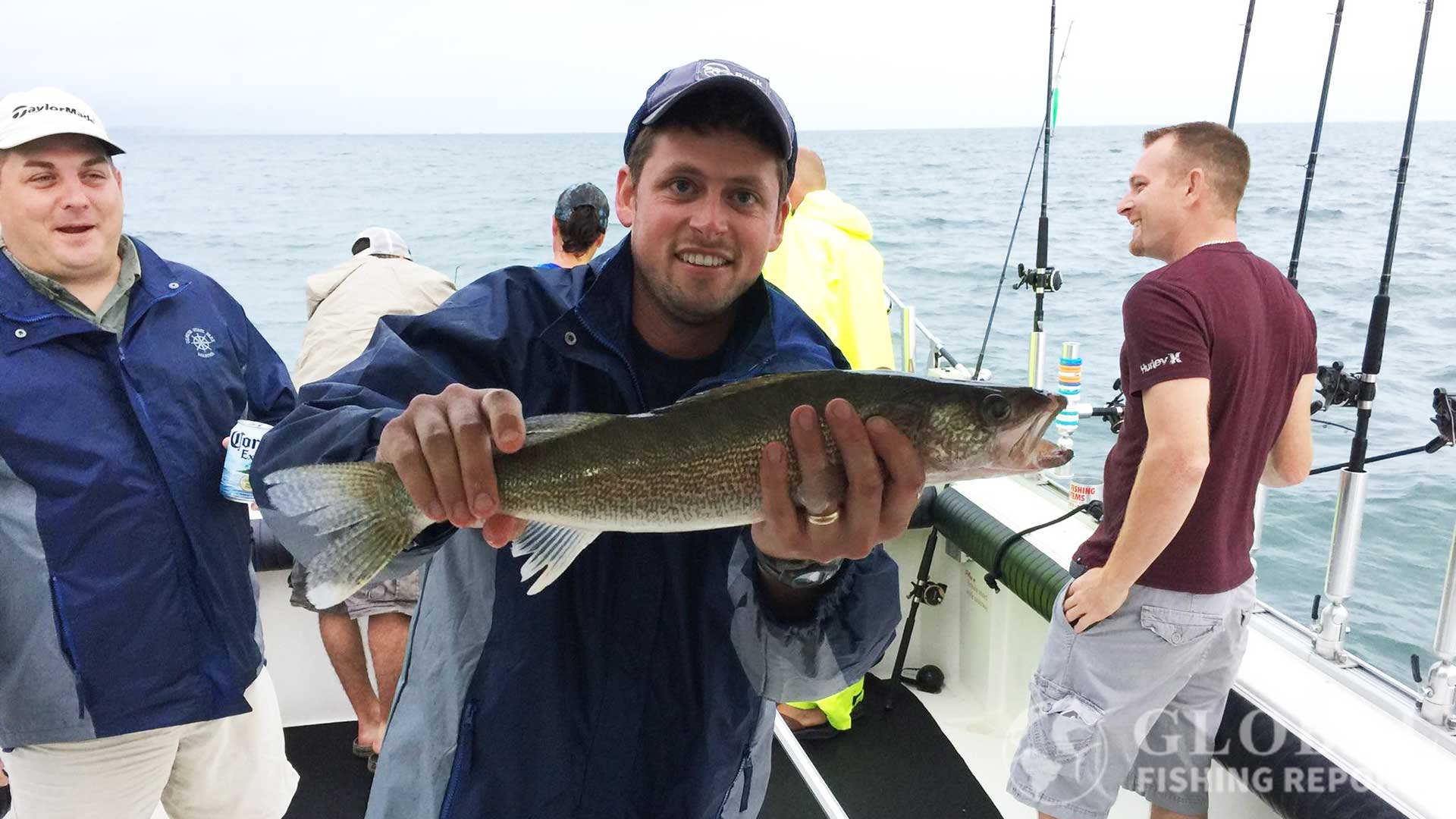
In the picture, my brother Mark is holding a walleye that was caught trolling in the Great Lakes, Lake Erie.
Husky Jerk Walleye Trolling Lure
The deep-diving husky jerk is similar to the bandit and is also used by many walleye charter boats in the Great Lakes. It comes in size 10 which is a 4-inch lure that dives 7-16 feet and size 12 that is a 4-3/4 inches long and dives 8-19 feet deep. The larges size is 14 which is 5-1/2 inches long and dives 10-20 feet deep.
This lure is neutrally balanced in the water and can be paused during the retrieve. Even when casting the lure it can dive about 10 feet deep. It also has a loud rattle which is good at attracting walleye. Features of the lure include diving lip, triple VMC black nickel treble hooks, and solid or translucent color patterns.
Storm Thunderstick Walleye Lure
This Storm Original Deep Thunderstick is 4-1/2 inches in length and weighs 5/8 ounce. It can dive to depths of 24 feet deep. There is a Storm Deep Jr. Thunderstick is 3-1/2 inches in length and weighs 5/16 ounce. This smaller lure can dive to depths of 15 feet deep. Good color options include black chrome orange, green clown, perch, and mossy orange fire UV.
Features of the lure include a deep diving lip, 3D eyes, VMC treble hooks, and a multi-ball high-pitch rattle. This is another popular lure for trolling at depths between 20 to 50 feet deep.
Cotton Cordell Walleye Diver Lure
The Cottom Cordell Wally Diver is a classic trolling lure for both walleye and smallmouth bass. It comes in sizes of 2-1/2 inch and 3-1/8 inch. Color options include chartreuse perch, chrome blue, chrome black, fire tiger, Fluorescent red, gold perch, perch, white red-head, and gold black. Fluorescent red is a great color when fishing under 15 feet deep and lures with green or silver are good at deeper depths.
The 2-1/2 inch lure dives up to 11 feet deep and the 3-1/8 inch dive up to 18 feet deep. Features of the lure include a built-in rattle, diving lip, and two treble hooks.
Rapala Fat Rap 05 Walleye Lure
The Rapala Fat Rap is one of my favorite lures for smallmouth bass fishing. It is also a good lure to catch walleye with. The listed diving depth is 5 feet but it dives much deeper when properly trolled. Color options for the lure are perch, silver, crawdad, and fire-tiger.
The lures length is 2 inches and it weighs 5/16 ounce. This is a classic crankbait that is made of balsa wood. Features include a deep-diving lip, great motion at all speeds, two VMC black nickel treble hooks, and each lure is hand-tuned and tank-tested. Many bass anglers use this as a casting lure but it also works great when trolling in 15-40 feet of water. When casting crankbaits baitcasting reels are commonly used.
Yo-Zuri Crystal Minnow Deep Diver Perch Lure
The Yo-Zuri Crystal Minnow is an extra-deep floating crankbait. It comes in sizes of 3-1/2 inch that can dive up to 12 feet, 4-3/8 inch that can dive up to 16 feet, and 5-1/4 inch that can dive up to 20 feet. Color options include acid perch, banana peel, chartreuse tiger, clear, clown, green perch, hot perch, hot tiger, midnight, and purple tiger.
Features of this lure are a durable clear coat, internal rattle, through wire constriction, extra deep diving lip, wide wiggling motion, and black nickel treble hooks. This lure can be cast or trolled.
Reef Runner Walleye Lures
The Reef Runner is another popular deep diving lure because it has a rated diving depth of 28 feet. In the 800 series, the lure is 4-3/4 inches long and weighs 5/8 ounces. Popular color options are blue prism, mixed veggies, wild things, salamander, and silver bullet.
Features of the lure include a deep diving lip, internal rattle, wobble action, and two number four treble hooks. There are also 500 and 600 series Reef Runner lures that are smaller.
Effective Worm Harness Setups for Walleye
Worm harnesses are extremely effective for walleye, combining flash, vibration, and scent to trigger strikes.
Berkley Walleye Mono Rig Worm Harness
The Berkley mono-rig is a worm harness with a single Colorado blade. Color options of the blade include fire tiger, black gold, black silver, blue silver, chartreuse, copper, flashback, hammered silver, and yellow perch.
It comes rigged with two in-line hooks with beads in-between. The leader is 48 inches long and is rigged with a 17-pound test line. It can be tied to a barrel swivel with a bullet-weight above. The leader can also be attached to a bottom bouncer for added weight. Drifting or slow trolling with a worm harness is a great way to catch walleye.
Berkley Indiana Walleye Rig Worm Harness
This Berkley Indiana worm harness is a basic rig with triple hooks. Blade options are hammered gold or hammered silver. The rig also has red and pearl white beads. It is rigged on a 12-pound test line. The three hooks have about 4-inch spacing and the overall leader length is 42 inches. For the leader material, it uses the Berkley Trilene XT monofilament line. Typically I like leaders that are around 17-pounds because walleye do have teeth. However, this rig will work for small to average size walleye.
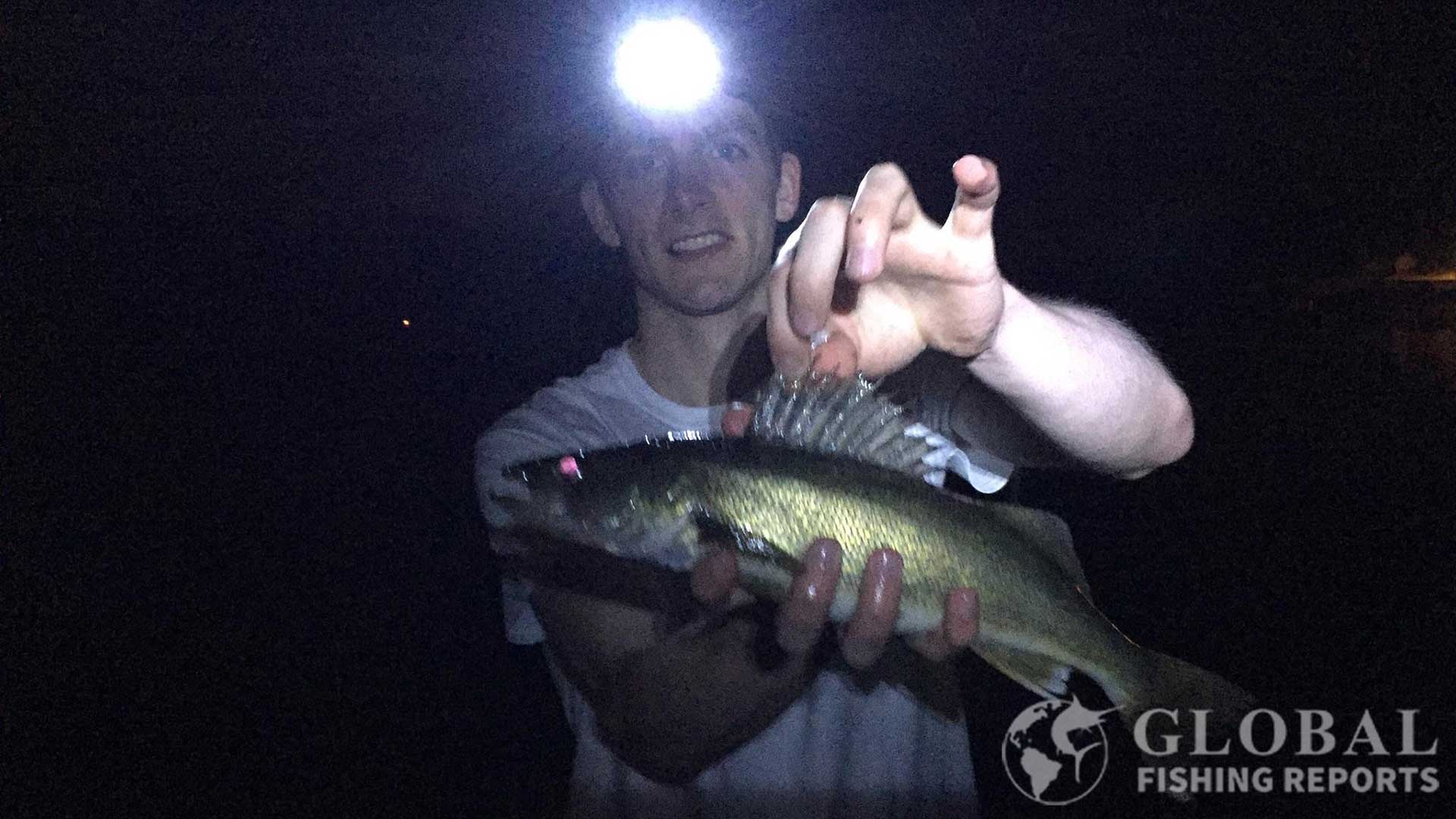
In the picture is a walleye that I caught in Lake Author in Pennsylvania during the night.
Viper Walleye Spoon Worm Harness
The Viper Spoon is a also a worm harness. Spoons are known to be great walleye lures as are worm harnesses. This lure combines both into one rig. Color options are green mackerel, bleeding pearl chartreuse, and silver.
This spoon has three hooks where worms or scented bait can be added. The first of three hooks is connected with a titanium line which protects the rig from being cut by walleyes teeth. This is a good spoon to use on a downrigger.
Gulp Nightcrawlers for Worm Harness
Nightcrawlers are a great bait to use on a worm harness when walleye fishing. However, live nightcrawlers are not always available. Berkley Gulp artificial nightcrawlers are a great alternative. These baits do not have to be kept cold and stay good for long durations.
The 1.8-ounce jar contains about 12 6-inch crawlers. These come in a natural color that looks very similar to real nightcrawlers. If you have ever used Gulp baits before you know they can be very effective at catching fish. The bait is durable and biodegradable which is great for fishing and the environment.
Powerbait Floating Mice Tails Walleye Bait
Berkley mice tails are three inches in length. Good colors for walleye include fluorescent-red natural, glow, chartreuse fluorescent-orange, and white bubblegum. These baits are most commonly used for trout but also work well for walleye.
The mice-tail can be added to a worm harness to add a visual attraction and a strongly scented bait. These can also be fish with a live bait rig similar to how a worm would be fished. Since the mice tails float they stay suspended off the bottom.
Bottom Bouncer Techniques
A bottom bouncer allows the worm harness to be kept right near the bottom. When jigging the bouncer off the bottom you can feel if the ground is rocky or muddy. For murky water, a short 20-inch leader can be used. In clear water a 3-foot leader is good. Spinners are also available that attach to the bottom bounces which make vibrations and help attract fish.
A three-way swivel is another way to add weight. This makes it so the bait gets further off the ground while still dragging weight on the bottom while drifting or trolling. This rig is a decent alternative to using a downrigger.
Walleye Spoons for Trolling
Spoons are versatile and effective lures for walleye trolling setups. When I fish with spoon I prefer to have them on a downrigger. This helps set the depth of lure just above the depth the fish are being marked. I have had the most success using light-weight and mid-weight spoons that maintain their action at walleye’s preferred slower trolling speeds. The flash created mimics injured baitfish perfectly in green stained water where walleye live.
Stinger Walleye Trolling Spoon
This is the NBK color pattern spoon which stands for Natural Born Killer. One great thing about spoons is that they all have awesome names like NBK! This color pattern works great on walleye, salmon, and steelhead. These come in 3-3/4 inch and 4-1/4 inch sizes.
Stinger Stingray spoons are lightweight and have great action at the slower trolling speeds used for walleye. Heavy spoons can be run straight out the back of the boat but this is not typically done for walleye unless lead core line is being used to get the lure deeper in the water.
The spoon is generally attached to a Dipsy Diver, jet diver, or downrigger. There are lots of good spoons out there that are primarily made for trolling for steelhead and salmon. Often time these spoons are bit heavier and are trolled at higher speeds.
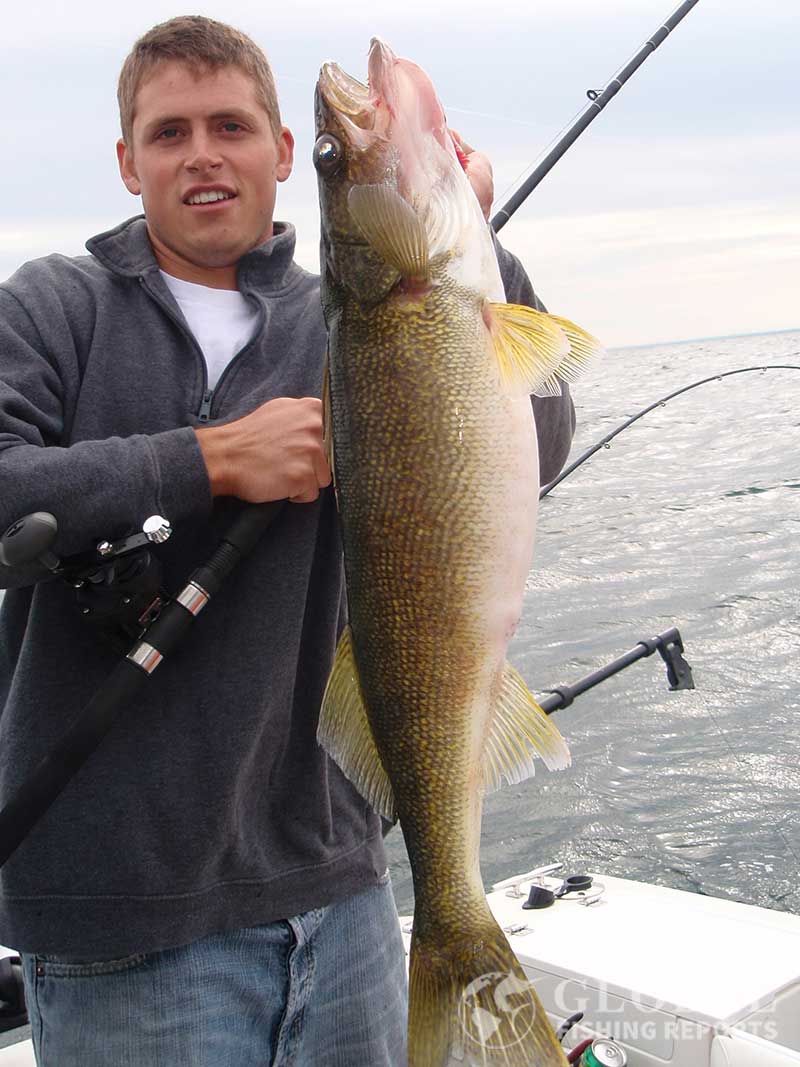
In the picture is a large walleye my brother Mark caught while trolling in Lake Erie.
Dream Weaver Walleye Spoon
Dream Weaver spoons come in 8 different sizes. The Super Slim size is 3-5/8 inches long and the standard DW spoons is 3-3/4 inches which both work well for walleye trolling. These are a bit heavier than other spoons a have the best action at the high end of walleye troll speeds.
Typical troll speeds for walleye are 1.5 -2.5 miles per hour and these work best at the 2.5 miles per hour troll speed. The Super Slim lures have a small honeycomb pattern and the standard spoon has a large honeycomb pattern. These come in a large variety of color patterns including silver alewife, NBK, dirty white boy, and mixed veggies.
Jigging Techniques for Walleye
When walleye are holding tight to structure or during slower drift conditions, jigging can be an effective approach. Jigging is lots of work but I like doing this when I have marked fish in a certain location on the fish finder. This can also be near a ledge or drop off. The key lies in recognizing where the walleye are located and jigging right where the fish are located. Raise an lower the jig from the bottom to 5 feet above where the walleye are located. The jigging motion mimics injured baitfish and allows you to maintain precise contact with structure where walleye often ambush their prey.
Blade Bait Walleye Jig
This is a classic lure that has been catching fish since the 1950s. It is 2 3/4 inches in length and weighs 1/2 ounce. Color options include silver shiner, fluorescent green crawdad, green flash, silver flash, gold flash, chrome, and blue flash.
This lure can be vertically jigged or cast and retrieved. This attracts walleye by vibrations caused by the jig fluttering as it moves through the water. Typically it is jigged by quickly pulling the bait off the bottom and then allowed it to flutter back to the bottom slowly.
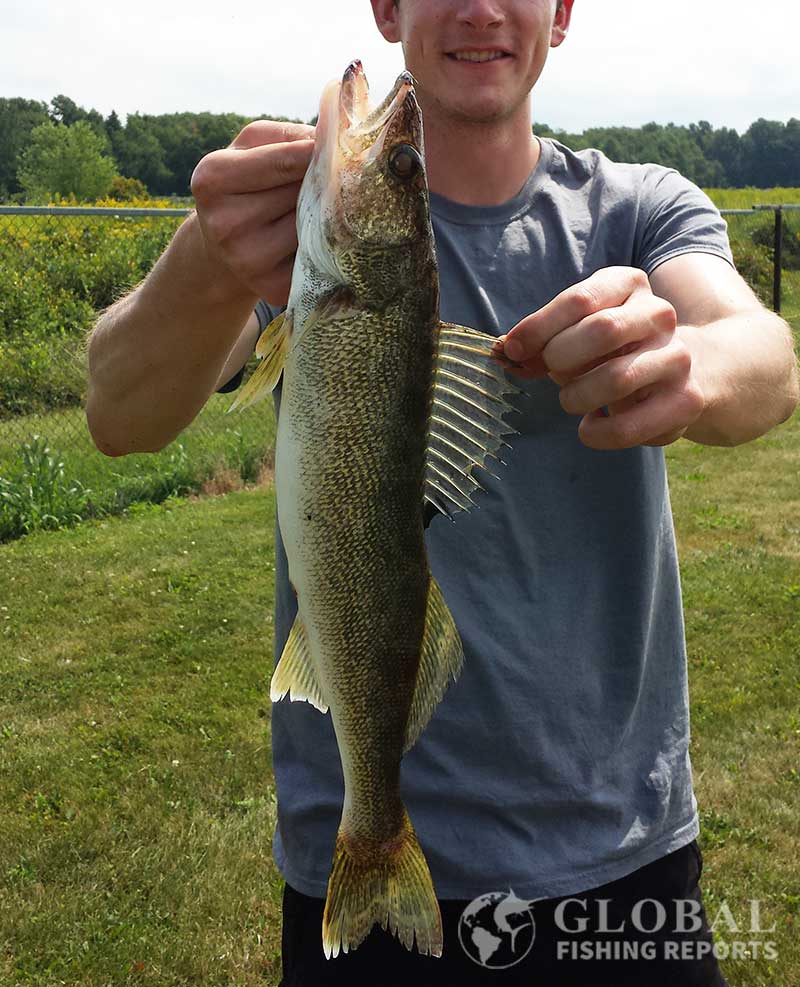
In the picture is a walleye that we caught while trolling for walleye in Lake Erie.
Zoom Salty Super Walleye Tube Jigs
Zoom Tube Jugs are a popular way to jig for walleye and smallmouth bass. Color options include disco candy, green pumpkin, rootbeer, watermelon red, watermelon seed, and white pearl silver glitter. Size options are 3.75-inch and 4.25-inch.
These baits are fished near the bottom and are intended to look like crayfish. Heavy crayfish jigs also work as well. The advantage of tube jigs is that scent can be added to fill the tube. A good scent is Liquid Mayhem Crawfish Scent.
VMC Walleye Tube Jig Hook
This VMC tube jig hook comes in weights of 1/16 ounce, 1/8 ounce, and 3/16 ounce. These are good for shallow water. For deep water, 1/2 ounce to 1-ounce jigs are good weights. The jig heads are made with a forged steel long shank with a 4/0 hook. The eyelet is rotated at a 60-degree angle which is good for swim jigs. The jig is placed within the tube so the fish do not see the jighead or base of the hook.
Erie Dearie Walleye Drift Bait
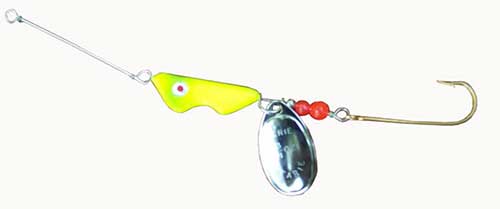
An Erie Dearie, which is essentially a weighted worm harness. Comes in 3/8, 5/8, and 3/4 ounce sizes. Color options include gold, green silver, and chartreuse silver.
A not very well-known alternative to adding weight to a worm harness is the Erie Dearie. It has the weight and spinner all in one which is very convenient! Simply add a worm, leech, curly tail, swim jig, etc. and the bait is ready to be fished.
Fishing For Walleye in Shallow Water
While many anglers focus on deep water walleye fishing, targeting them in shallow water can be incredibly productive, especially during spring, fall, and at night. In shallow water environments, crankbaits and spinners are my go-to lures because they allow for effective coverage with the right amount of vibration and flash. Walleye often move to shallow flats, rocky points, and weed edges when hunting for baitfish, making these prime areas to cast crankbaits that dive 3-10 feet or spinners that can be retrieved just above structure. The key is understanding seasonal patterns and light conditions that trigger walleye to move shallow.
Husky Jerk Walleye Crank Bait
The Husky Jerk is known to be a great lure for northern pike, pickerel, and musky but it is also a great lure for walleye. Husky Jerks come in many sizes including HJ06 2-1-2 inch 1/8 ounce, HJ08 3-1/8 inch 1/4 ounce, HJ10 4-inch 3/8 once, HJ12 4-3/4 inch 7/16 ounce, and HJ14 5-1/2 inch 5/8 ounce.
Color options include glass purple Sunfire, green, baby bass, fire-tiger, glass perch, class pink clown, silver, and red fire crawdad. These lures can be trolled on a dipsy diver, jet diver, or downrigger. It can also be cast in shallow water when walleye come nearshore and to shallow shoals to feed in late fall, winter, or early spring. This crankbait also works well near shore at night when the water is still cold in shallow depths.

In the picture is a walleye my Uncle Bob caught while fishing a lake in Illinois.
Mepps Spinners Walleye Kit
Mepps has specific kits with lures that are known to be productive for bass, northern pike, trout, salmon, and walleye. There is also an Alaska Bonanza Kit, Ultra-Lite Kit, and a Canada Bonanza Kit. Mepps knows which spinners work best for each type of fish.
For this walleye kit there are are several number three spinners, a Comet-Mino, and a gold spoon with red highlights. All of the spinners have solid brass bodies and single blades. If you like using spinners with freshwater spinning reels than this is a great kit to fish for walleye with.
Best Walleye Fishing Conditions
Nighttime Tactics
Walleye are typically thought of as fish that live in 20-80 feet of water. However, at night is common to find walleye on shallow shoals and along shorelines searching for baitfish. A good way to find walleye and all other types of predator fish is to locate schools of bait. Fishing along ledges can also be effective at night and during the day.
Color Selection Based on Water Clarity and Depth
The best walleye lures colors are green, red, silver, and black. Walleye do have good eyesight and can see particularly well in low light conditions. However, walleye can not see blue or yellow. Walleye can see red and green. So a red and green lure or lure with flash and contrast can help attract walleye. Lure vibrations, rattles, and scents also help attract fish to the bait.
Walleye Scented Baits
The best baits for walleye include minnows, perch, suckers, creek chubs, crayfish, leeches, nightcrawlers, and Gulp scented baits. These baits can be alive or dead but motion does help attract walleye. Scented tube jigs also make a great bait. For lures, deep diving plugs, spoons, crankbaits, and stick baits are all commonly used.
Effectiveness of Scented Baits
Yes, scented baits absolutely help attract walleye. This is especially true when slowly drift fishing. Sent is not required as plugs and spoons do commonly catch walleye. Live baits work as well. Artificially scented baits like Berkley Gulp Crawler, Gulp Nightcrawlers, and Powerbait Floating Mice Tails can also be used on worm harnesses or live bait rigs.
Common Questions About Walleye Fishing
Do walleye die when caught in deep water?
Walleye can die when they are released after being caught at depths over 50 feet. Walleye have swim bladders that contain a significant amount of air that can only be increased or decreased by diffusing or absorbing gas through their blood. Bringing the fish up really slowly might help give the fish time to absorb some of the gas but most fishermen are not that patient.
A swim bladder deflating device or vent tool is used by some people to pop the swim bladder so the fish can swim back to depth. The problem in the puncture hole can injure or kill the fish if it becomes infected. Studies have shown a high death rate among vented fish.
A fish descender is the best way to bring the fish back to depth. A fish descender is placed on a weight that pulls the fish back to depth and recompresses the air in the swim bladder. For walleye, it is much easier to just fish in water that is less than 40 feet deep when possible!
When taking scuba certification training it is taught that a 33 feet water depth change results in a pressure change of 1 ATM which ultimately results in the air volume doubling. The swim bladder expands significantly at depths greater than 40 feet.
Will walleye eat dead minnows?
Yes, walleye will eat dead minnows although that is not a common walleye bait. Live minnows are a common walleye bait. When perch fishing dead minnows are common bait and walleye can be caught at the same time. There are artificial scented baits and jigs that are just as good or better than dead minnows when walleye fishing. It is important to have some motion to the bait.
How long do walleye live?
Most walleye are less than six years old but walleye can live up to 29 years. A 1-year-old walleye is about 10 inches in length. At age 5 walleye are about 20 inches long. Once reaching a length of 30 inches the fish is about 12 years old and weighs about 10 pounds.
What is the weight of an average size walleye?
An average size walleye is 12-20 inches and weighs between 1 and 3 pounds. The world record walleye was 22-pounds 11-ounces and was caught on Greer’s Ferry Lake, Arkansas. Any fish over 30 inches or 10 pounds is considered a very large walleye.
Are walleye good to eat?
Yes, walleye is considered one of the best freshwater fish to eat. Like most fish, it contains omega-3 fatty acids which are healthy fats. Walleye can contain mercury depending on which lake it was caught in which should be considered when frequently consuming fish. Smaller fish typically have less heavy metals and eating walleye between 15 inches and 18 inches is a good size. This would be approximately a 1-2 pound fish. Not keeping the older larger fish is also helpful for keeping the walleye population in large numbers.
What Fishing Line should be used for Walleye
Walleye are not a particularly strong fighter so super heaver gear is not needed. They do have fine teeth that can damage or cut a leader. A 10-20 pound mainline is typically used with a 10-20 pound fluorocarbon leader.
For big walleye, a 17-20 pound leader is preferred. When fishing any type of fish can bite so it is better to have a line that is stronger than expected to be needed. That being said it is fun to catch all types of fish on light tackle.
Captain Cody has worked on charter fishing boats in the Florida Keys, Virgin Islands, and Alaska. Growing up in Pennsylvania Cody has also done extensive freshwater fishing including bass fishing tournaments. Cody strives to provide detailed information about the best fishing gear and tactics to help both novice and experienced anglers have a more productive and enjoyable time on the water. Cody also has a background in aerospace engineering and neuroscience but really only takes pride in being good at one thing and that is fishing!





